Folding kitchen tables: types, materials and tips for choosing
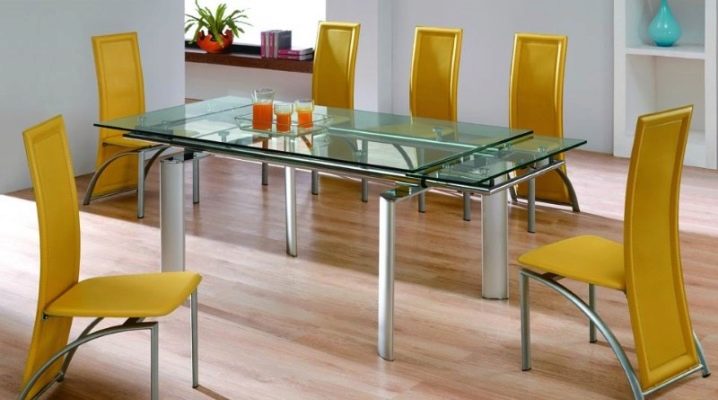
A table is a necessary piece of furniture in the kitchen. If the room is so small that there is nowhere to put it, there are a lot of design ideas with which the countertop can be transformed literally out of nowhere: walls or a headset.
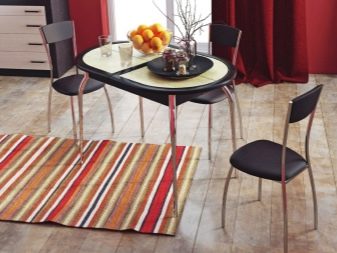
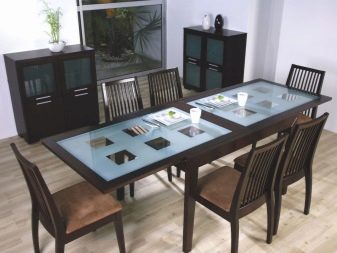
Peculiarities
The kitchen folding table is of two types: working and dining. Additional cooking surfaces are laid out from the headset modules and are located in the working area. The dining tables are slightly removed from the workplace. In order not to take up extra space in the kitchen, they are made compact, but with a folding function.
Do not think that transforming furniture is the lot of only small rooms. Beautiful, sturdy tables of various shapes and sizes can have folding elements to become even larger and more spacious.
Each type of folding mechanism has a right to exist, as it is reliable, simple and easy to operate.
Tables can be laid out, extended, moved apart, reclined. Over the centuries of working with transforming mechanisms, the industry has brought them to perfection.
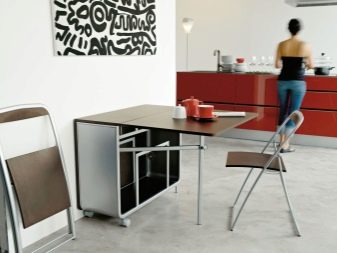
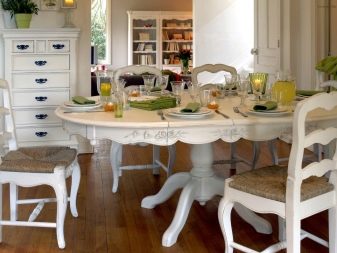
Advantages and disadvantages
Choosing a table, people are trying to solve two opposite problems at the same time - they want spaciousness and discretion from it. To understand how these tasks are feasible, consider the advantages and disadvantages of folding tables.
Transforming tables have many advantages:
- compactness allows them to be almost invisible, but, if necessary, turn into a full-fledged table;
- many types of products are quite functional, they have additional drawers and shelves;
- only high-quality material is suitable for the manufacture of tables, since they have to be re-unfolded, so the products are reliable and durable;
- some folded table models not only take up little space, but also hide folding chairs in their design;
- a wide variety of types with different mechanisms, shapes, from all kinds of materials, allow you to choose a table in a specific kitchen, taking into account the allotted space and style.
The disadvantages include the difficulty in choosing a place, especially for retractable and folding products. When assembled, they are invisible, but when the table is installed and "overgrown" with chairs, it requires a certain amount of space. The cost of folding models is noted, which is higher than that of conventional tables, since additional materials are used for their manufacture.
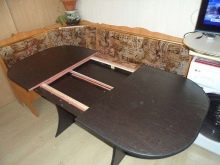


Views
Transformers are very diverse, they differ from each other in size, shape, color, material. But their main difference lies in the folding mechanism, which leads to an increase in the table top. Let's take a closer look at each transformation method.
Book-table, or "butterfly"
Book tables have been known for a long time, they are very popular because of their simple and reliable way of laying out. This table was a favorite piece of furniture in the Soviet Khrushchevs. In cramped conditions, it is ideal to have a narrow pedestal against the wall, it takes up almost no space. If guests come, the owners rearrange the curbstone to the sofa and raise the side surfaces that were hanging on hinges a minute before.An elegant but strong support leg is hidden behind the sidewalls, it is installed diagonally, and the side surface lies on top.
So, in an instant, a small curbstone turns into a huge table. If few guests come, it is enough to lift one sidewall.
In Soviet times, the butterfly table had few types. A heavier cabinet was equipped with shelves and even doors. The lightweight version, when folded, was an empty cabinet, on the surface of which only a few photographs or figurines could be placed. Modern book tables are more diverse:
- lightweight options perform only the function of tables that do not have additional storage space;
- a full-fledged curbstone-table with a functional storage system hidden behind the doors;
- the curbstone of the folding table is equipped with drawers;
- one-sided book-table with open shelves;
- small kitchen table with small wings;
- tables have different types of supports: one on each side or two, set diagonally, in the center, along the edges.
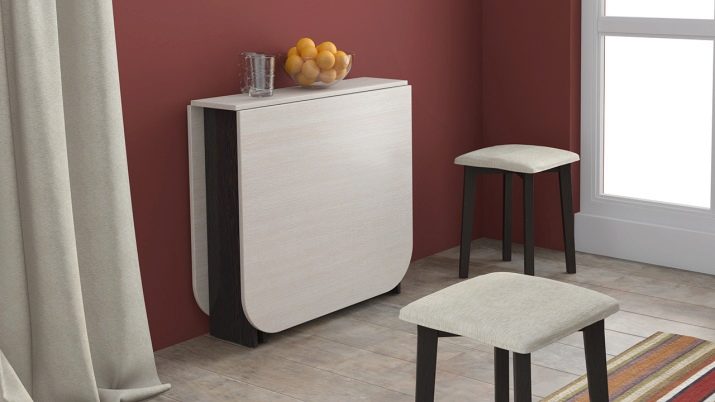
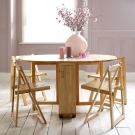
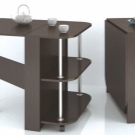
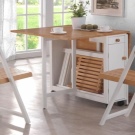
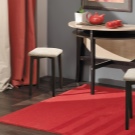
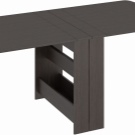
Folding swivel
The swivel mechanism is simple and straightforward. Based on it, they came up with several options for tables.
- The method of unfolding the structure is extremely simple. The small table has a double top. To unfold it, first turn the surface 90 degrees, and then open it like a book.
- A full-fledged functional cabinet contains a lightweight table on its surface, which has only a tabletop and one sidewall on casters. One has only to pull, and the table will drive off, then unfold, and you get a bar counter.
- There are expensive types of tables with mechanical rotation. One has only to slightly pull the tabletop, and it will unfold, setting itself in place.
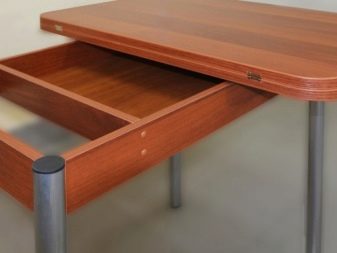
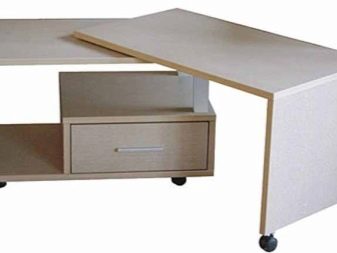
Sliding
The table top consists of two halves. To expand the structure, you need to move it apart in different directions.
There is a section under the table surface, which should be removed and placed in the center. This is how the three-piece worktop forms a single unit.
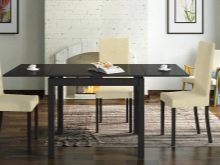
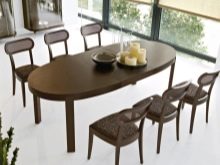
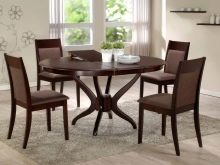
Folding
Folding tables are an ingenious design for small kitchens. When folded, they form a panel on the wall. When it's time for dinner, the tabletop is simply lowered down. Designers have developed many models of folding tables, everyone can choose the best option for their kitchen.
- A narrow panel is attached to the wall, on which only a few cups can be placed. The table top hangs down.
- An even more compact option that doesn't even have a narrow panel. A swivel leg is mounted on the wall, and a small tabletop is mounted to it. When folded, such a structure is a tabletop, vertically mounted on the wall.
- For those who believe that a radiator takes up a waste of space in a small kitchen, a model of a folding table has been invented, "absorbing" the battery. Convenient multi-functional two-in-one design. But there is a drawback - when folded, such a table interferes with the circulation of warm air.
- For minimalist styles, a design was invented in the form of a very narrow wall cabinet, which includes a tabletop. The cabinet-panel is played up with a color scheme, or they choose a shade to match the wall and completely dissolve in space, or they are painted in a catchy color and turned into a simple ascetic decor in the form of a bright spot in the room.
- There is a practical design that combines a handy hanging cabinet with a countertop. The model is suitable for styles of minimalism, modern, urban trends, since when assembled it is a box on the wall, closed on all sides.
- Kitchens with sufficient space also use folding models. But they can afford to fix them not on the wall, but in the center of the room on the installation. The structure looks like an extremely narrow island with two hinged panels.
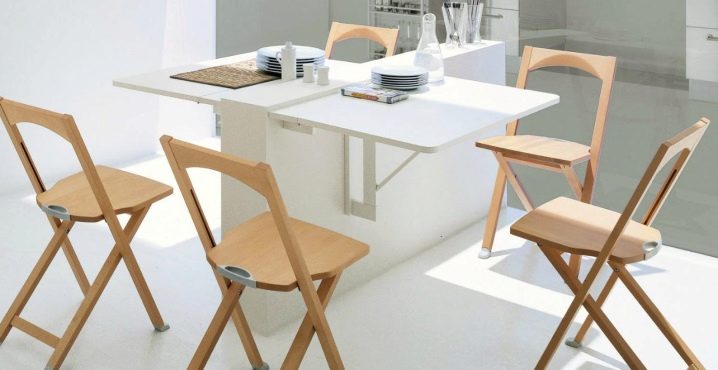
Retractable
The table is laid out by the pull-out method, that is, it moves out of the stationary furniture. At the same time, telescopic folding or swiveling is not always ready-made.
- The bar counter on casters rolls out of the side cabinet. With the help of a rack groove fixed to the headset, the tabletop can travel around the kitchen, move any distance.
- Sometimes a table top comes out of the working wall, which breaks the idea of space. It’s hard to believe that she could fit in the space allotted to her.
- The same impression is left by telescopic structures when a spacious table appears from an ordinary kitchen drawer.
- Sometimes in a telescopic way, the table leaves a small box on the wall, representing a model of a transformer.
- To increase the area of the countertop hidden in stationary furniture, it is pulled out and laid out like a book, or in another way.
- Pull-out tabletops are hidden not only in the headset. Sometimes they are masked in the island element.
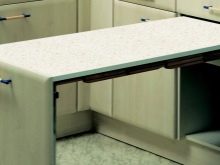
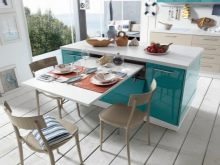
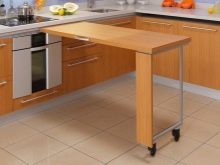
Materials (edit)
For a table, especially a transforming one, it is important that it be strong, stable and durable. Frequent unfolding may affect its durability. So that the design does not fail, any selected material must be of excellent quality.
The kitchen table in the dining area is a rather noticeable piece of furniture in the interior. The inconsistency of the material with the general style will bring disharmony into the situation. Therefore, when choosing a table, you should definitely take into account the design of the room. With a variety of materials, making the right choice is easy.
Glass
Glass tables in our kitchens cannot be called a frequent occurrence; many consider them impractical. But there are situations when such material justifies itself. In small rooms, with the right design, a transparent table will let space through itself, it will not only not reduce it, but even add volume.
Glass tables perfectly play along with some styles, such as fusion, modern, minimalism.
But it is worth remembering that daily use of the glass surface for eating will require frequent and careful maintenance. Therefore, such tables afford bachelors who rarely eat at home. Or the owners of large dining rooms, which have several tables in the interior.
For the manufacture of the table, tempered high-strength glass is suitable, covered with a transparent protective layer that protects against scratches and other damage. It is a multi-layered water-repellent structure that responds well to temperature changes, which means that hot spilled coffee will not harm it. Fasteners are chosen graceful, but especially strong, capable of withstanding frequent unfolding.
Glass tables are produced in the correct geometric shape. In addition to transparent options, they produce tinted, patterned, glossy coating, decorated with foil and varnish.
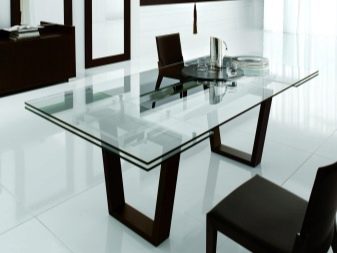

Wood
A century ago, wooden furniture was a common thing for every family, regardless of material status and class. Today, solid wood products are expensive, so wood-fiber products (MDF) are widely used.
Wood is an environmentally friendly natural material. Each breed gives its own unique shade and pattern. With tactile contact, you can feel how pleasant the wood is, it exudes warmth and comfort. Therefore, comfortable rustic styles prefer to see only wood in their interiors.
Before making furniture, wood is treated with antifungal impregnations. The folding tables are made of solid wood: ash, oak, walnut, beech. Less commonly used rocks of medium hardness: birch, alder, cherry. Products made of soft material are easily susceptible to mechanical damage. The tables look very nice, but they are afraid of contact with water and require more careful maintenance.
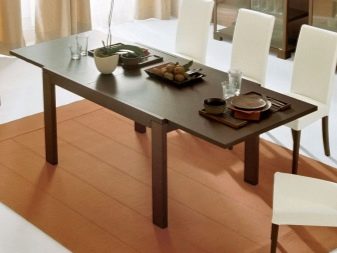
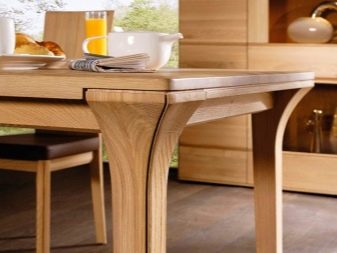
Veneer
Today, the largest percentage of furniture is made from MDF and chipboard, they belong to budget materials.Veneer is thin sheets of wood (0.1-10 mm) that are glued onto pressed boards, creating an imitation of real wood. Tables made in this way are quite durable, they contain the pattern and color of any, even exotic wood. They can be washed, they are resistant to scratches, but, like natural solid wood, they do not like prolonged contact with water.
In addition, frequent contact of veneer with hot dishes can lead to dry glue and deformation of the table surface.
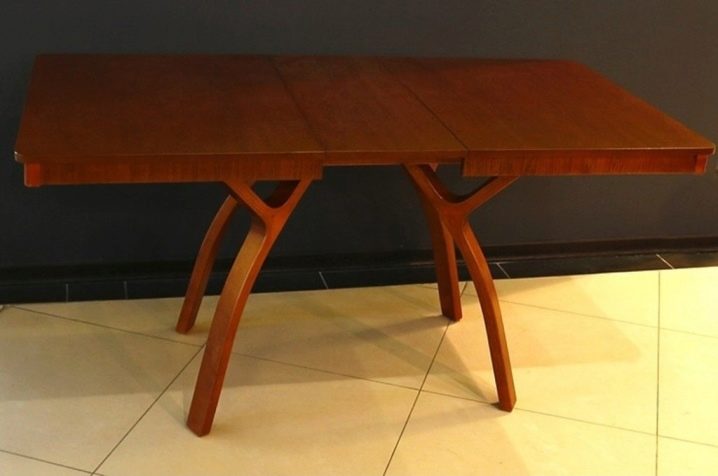
Metal
Tables made entirely of metal are hard to imagine in home kitchens. They are used to equip canteens, production workshops, and a cozy living interior can only withstand fragments of cold metal. Most often, legs and a base under the countertop are made from it. The strength of the material allows you to create thin, but reliable supports, and the tabletop itself is made of glass, wood or MDF. The grace and brilliance of glass is especially successfully combined with the sophisticated cold forms of metal.
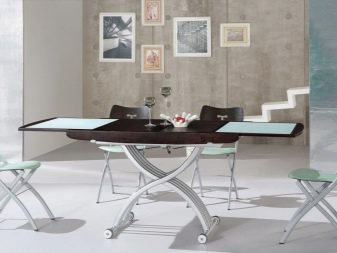
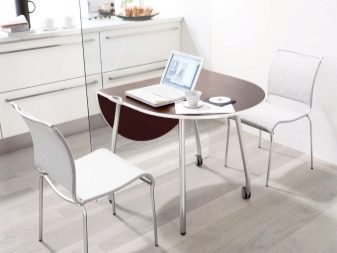
Plastic
For the manufacture of sliding tables, durable types of plastic are used that can withstand high temperatures, do not lose their appearance when in contact with hot objects. Plastic tables are not afraid of water, they are easy to care for. Modern types of products are well washed with household chemicals without prejudice to them. These tables are inexpensive, lightweight, and can be moved anywhere every day.
The negative aspects include the seams, which are often visible on the product, sometimes they give off an unpleasant odor, are toxic during a fire and do not look as elegant as natural materials.
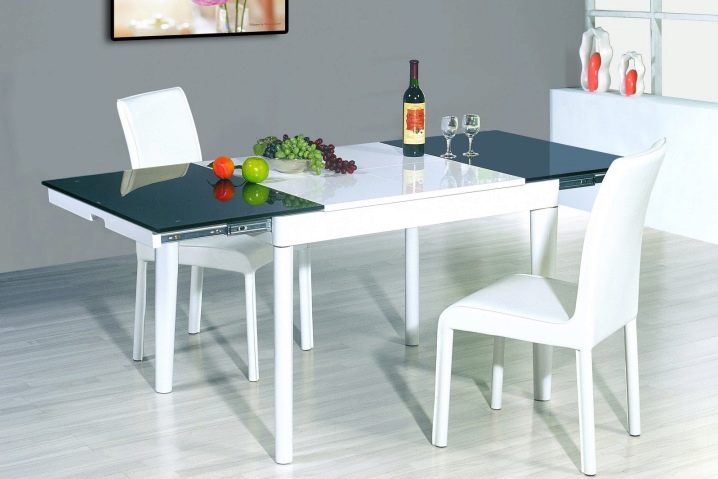
Stone
Due to its high weight, natural stone is not used for the manufacture of folding tables. It is used to produce thin facing tiles, which are used to cover the product. Stone tables are beautiful, durable, and resistant to temperature changes. But the porous material absorbs liquid. If, for example, coffee is spilled on a marble surface and is not removed in time, the stain will remain on it forever. The stone does not like the effects of household chemicals and is too expensive.
You can purchase a folding table made of artificial stone (quartz or acrylic). It is made from polymer resin and natural stone chips. This material has no problems with porosity, it repels water. Artificial stone is resistant to different temperatures, easy to maintain and looks pretty decent.

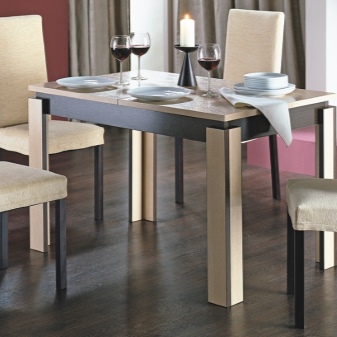
Ceramics
Ceramic tabletops for folding tables are made using several technologies. In one case, the ceramic layer is simply laid on the prepared substrate. The requirements for caring for such a table will be the same as for ordinary tiles - it reacts normally to household chemicals, but is afraid of the use of abrasives. The second way is to combine ceramics and glass.
Tabletops are often installed on metal legs, but sometimes wood is also taken as a basis.
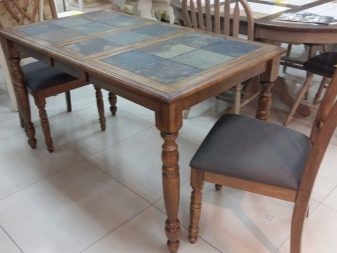

How to choose?
First of all, you need to decide on the size of the product. Three factors affect the size of the table: the space allocated for it, the number of household members and how often guests are in the house.
The design features of the model largely depend on the place. The table belongs to folding products, which means that it has to increase in the direction where space is provided for it.
If there is a small area in front of a free section of the wall, you can purchase a folding wall table. The U-shaped layout of the headset does not leave open walls; here you will need a retractable option that leaves the furniture section.
For a more spacious kitchen or dining room, you can afford a full dining table with a folding function.
When choosing a product, you should pay attention to its functionality. The table can be with shelves, a drawer or a closed cabinet. The shape, color, texture and material of construction depend not only on the taste of the owner, but also on the style of the interior.
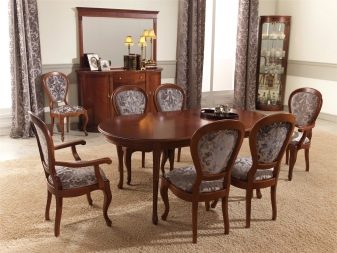
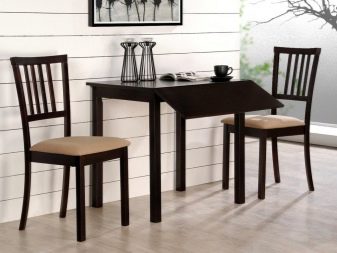
Sizes and shapes
The shapes of tables are most often square, rectangular, round, oval. When choosing a table in the kitchen, you need to take into account that the round or oval version is not suitable for small rooms. They cannot be placed in a corner, besides, the circle implies the arrangement of chairs from all sides. If the style of a tiny kitchen requires smooth lines, a semicircular table is purchased, which is placed against the wall with a cut.
Round and semicircular models are installed in the center of the room, they are beautiful and solemn. Due to the lack of corners, a large number of guests can be accommodated behind them.
Square and rectangular tables are suitable for any size and style. They are easy to unfold, their traditional shape is more familiar to modern users.
The size of the selected model directly depends on the space allocated for it. Standard products do not exceed a height of 75 cm, and the dimensions of the countertops are 70x70 cm or 70x100 cm.
The modern manufacturer often deviates from the intended standards in favor of a variety of designs and customer satisfaction.
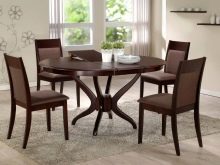
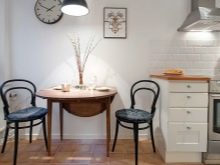
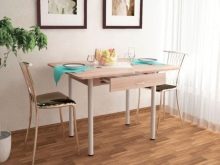
Color and design
The variety of folding tables allows you to integrate them into any interior design. They have a rich color palette. If we take wood, each product has its own special pattern and shade. Even glass countertops are not without variety. In addition to transparent options, they come in a calm smoky color or with a bright photo print.
Transformers will suit any style, you just need to choose the right material and color. For example, rustic and ethnic styles prefer wood, while industrial styles will not mind glass and metal structures. Let's take a closer look at stylized models.
Shibby chic
This trend is characterized by light, almost faded shades and represents "aged splendor". Expensive furniture looks like it has stood for centuries. The folding table should have non-modern shapes, and its surface should be whitened and aged by different techniques.
The photo shows how you can restore a folding serving table in the shabby chic style with your own hands.
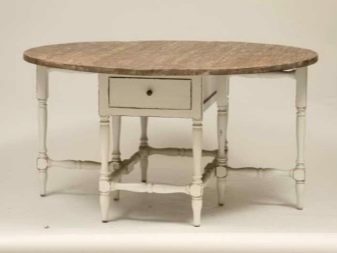
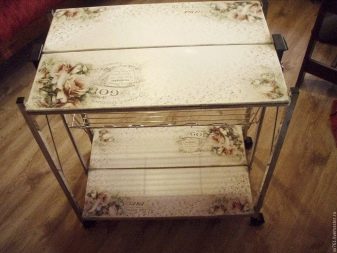
Provence
Furniture in the style of a French village also has an almost antique look, but unlike shabby chic, it does not need to emphasize luxury, it is enough to restore grandmother's table, as long as it is made of natural wood.
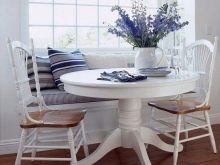
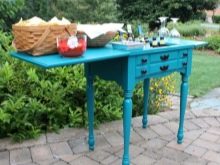
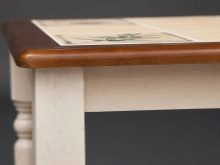
Hi-tech, minimalism
These styles prefer clear geometry, the cool sheen of glass and metal, while still being practical and functional.
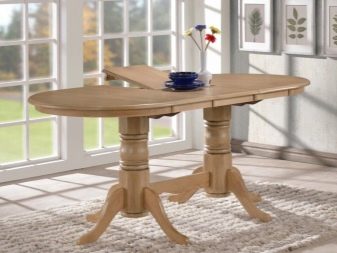
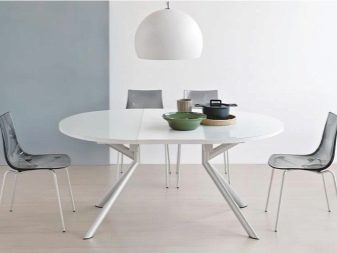
Loft
The style originated in the huge premises of abandoned factory halls. Its interior uses brick, wood, and a lot of metal. The photo shows the product, the legs of which reflect the industrial theme.
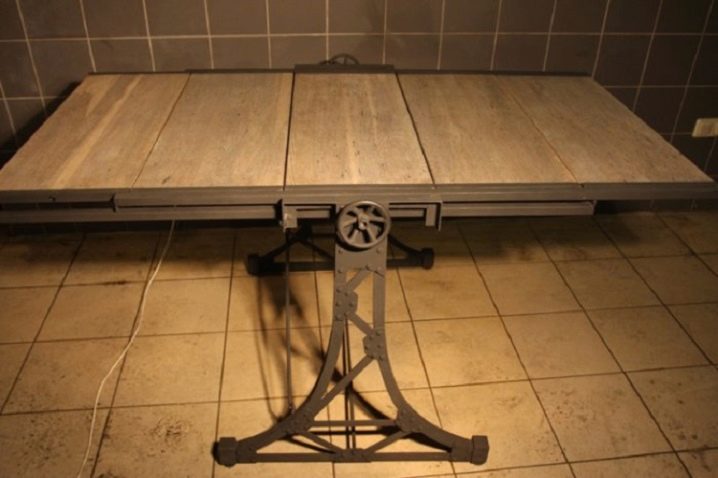
A folding table is indispensable in modern kitchens; it solves the problem of receiving guests in a civilized way. Otherwise, in order to seat everyone, it would be necessary to move several diverse structures.
For information on how to make a folding table with your own hands, see the next video.













The comment was sent successfully.